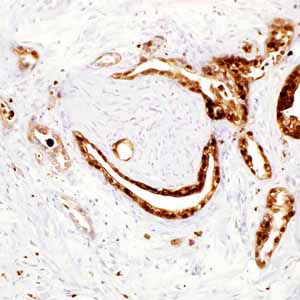
S100P (16/f5)

S100P is a member of the S100 family of proteins. The family is expressed in a wide range of cells and is thought to play a role in cell cycle progression and in differentiation. S100P was initially identified in the placenta at rather high levels. Anti-S100P with nuclear or nuclear/ cytoplasmic immunoreactivity can be seen in essentially 100% of pancreatic ductal adenocarcinoma in pancreatic resection, and fine needle aspiration biopsy specimens. Anti-S100P displays no staining in the benign pancreatic ducts and acinar glands. S100P has been detected in the cells of virtually all intraductal papillary mucinous neoplasms tested. S100P is clearly expressed in the invasive component of intraductal papillary mucinous neoplasms (100%), including perineural, lymphatic, and minimal invasion. Biopsies of bile ducts with primary adenocarcinomas (90%) have exhibited strong nuclear and cytoplasmic staining for anti-S100P, with none of the 32 benign biopsies exhibiting anti-S100P immunoreactivity. An immunohistochemical panel including anti-S100P can be helpful in distinguishing adenocarcinoma from reactive epithelial changes on challenging bile duct biopsies. The detection of S100P expression may help distinguish urothelial carcinomas from other genitourinary neoplasms that enter into the differential diagnosis.1-6
